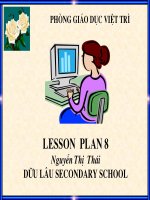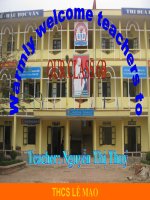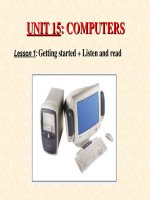Unit 15 Computers -Tiếng anh 8
Bạn đang xem bản rút gọn của tài liệu. Xem và tải ngay bản đầy đủ của tài liệu tại đây (283.05 KB, 16 trang )
SUOI NGO SECONDARY SCHOOLENGLISH 8
Lesson plan
UNIT 15: COMPUTERS
Division of Lessons
I.
OBJECTIVES: Help students: - Enrich their vocabulary.
- Know the useful things of computers in the modern life.
II. LANGUAGE CONTENTS:
1. Grammar: Present perfect
2. Vocabulary: plug, manual, connect, printer
III. TECHNIQUES: -True or false - Fact or opinion - Rub out and remember
IV. TEACHING AIDS: Extra-board, cassette player, picture
V. PROCEDURE:
TEACHER’S AND STUDENTS’ACTIVITIES CONTENT
- It’s a modern machine. We use it to type letter,
send e-mails or play games. It begins with letter
C. (Computer)
-Ss work in pairs to make a list of how computers
can help us.
-T introduces the situation before they listen. Ss
listen to the tape.
-T uses pictures to elicit and explain new words.
Ss practice pronunciation. Check vocabulary by
rub out and remember.
- Ss listen to the and repeat twice
-They practice the dialogue in pairs then practice
i. warm up
Guessing:
GETTING STARTED
- Computers help us learn interestingly.
- Computers help us learn more quickly.
- Computers are convenient for keeping
information.
- Computers are very quick in giving and answering
questions.
ii. Presentation:
LISTEN AND READ
- plug (n): phích cắm
- manual (n): sách hướng dẫn sử dụng
- connect (v): kết nối
- printer (n): máy in
TEACHER: THUY DUNG page 1
Period Lesson Part
100 1 Getting started & listen and read
101 2 Speak
102 3 Listen
103 4 Read
104 5 Write
105 6 Language focus
Week: 33
UNIT 15: COMPUTERS
Lesson 1: - Getting stared
- Listen and read
Period: 100
Date: 10/05/2014
SUOI NGO SECONDARY SCHOOLENGLISH 8
the dialogue in front of the class.
-T corrects their pronunciation.
- T reminds Ss of Fact and Opinion.
- Ss decide each statement is Fact or Opinion.
-Feedback.
- Ss do true or false in pairs.
-T calls some pairs to present and give marks if
they are excellent.
- T guides her Ss to do homework.
Present perfect: I have already done it
III. Practice:
1. Practice the dialogue in pairs.
2. Fact or Opinion
a. F b. O c. O d. O e. F f. F
F O
Computers store information
Computer are very helpful
Computers are
iv. Production :
Marks
True or False
1. The printer isn’t working.
2. Nam has already turned the computer on
3. Nam knows how to connect a printer but he
hasn’t connected it properly.
4. The manual helped them to find out the
problem.
5. Mr Nhat bought the computer in HCM city and
it’s still under guarantee.
6. Mr Nhat thinks the company wouldn’t do
anything with his computer because it’s too far
from his place.
Answer key
1. T 2. T
3. F and he has connected it properly
4. F 5. T
6. F Mr Nhat thinks the company should do
something with it
V. HOMEWORK:
- Practice the dialogue and do exercises again.
- Prepare: Unit 15-Speak
- Do: Exercise 1/P.85
COMMENTS
………………………………………………………………………………………………………………………………………………………………………………………………………………
………………………………………………………………………………………………………………………………………………………………………………………………………………
………………………………………………………………………………………………………………………………………………………………………………………………………………
………………………………………………………………………………………………………………………………………………………………………………………………………………
TEACHER: THUY DUNG page 2
Week: 34
Revision
1
Period: 96
Date: 10/04/2015
SUOI NGO SECONDARY SCHOOLENGLISH 8
I. OBJECTIVES:
Help students review some main grammatical point in the second semester.
II. LANGUAGE CONTENTS:
1. Grammar:
1. in oder to, so as to
2. Future simple
3. Modal “Will”to make requests, offers and promises
4. –ed and –ing participles
2. Vocabulary:
III. TECHNIQUES: Rewrite sentences, make sentences, find mistakes
IV. TEACHING AIDS: Extra-board
V. PROCEDURE:
TEACHERS’ AND
STUDENTS’
ACTIVITIES CONTENT
T reminds Ss the
grammatical point
- Ss follow and copy
down.
I. WARM UP:
II. PRESENTATION:
1. Phrase of purpose:
- So as to/ In oder to: để mà
Ex: She study hard in order to/ so as to pass the exam.
2. Adjectives following by:
+ An infinitives: S + be + adj. + to V
Ex: She is happy to hear the new
+ A noun clause: S + be + that + S + V
Ex: she is happy that she hear the new
III. PRACTICE:
1. Find the mistakes
1.It not difficult to remember all the students’ names in a class.
*A B C D
2. Lan is going to Australia in order learn English next year.
A B *C D
3. He delighted that you are interested in protecting environment.
*A B C D
4. His painting will exhibited for the first time by New Art gallery.
*A B C D
3. Write the sentences.
1. We / delighted / get / your letter / yesterday.
2. It / not easy / answer / these questions.
3. your writing / difficult / read.
4. I / surprised / see / Paul / the party / last night.
Keys
1. We were delighted to get your letter yesterday.
2. It is not easy to answer these questions.
3. Your writing is difficult to read.
4. I was surprised to see Paul at the party last night.
IV. PRODUCTION:
TEACHER: THUY DUNG page 3
SUOI NGO SECONDARY SCHOOLENGLISH 8
- T gives the exercises.
- Ss work in pairs to do
the exercises.
- Ss present their works.
- T gives keys. Ss correct
themselves
- T guides her Ss to do
homework.
Find the mistakes
5. They let me to do what I want with the hope that I can do my best.
A *B C D
6. We can reused things like envelopes, glass, plastic bottles and old plastic bags.
*A B C D
7. What do you think about the students play over there?
A B * C D
8. Hue is only a 15-minutes drive from Phu Bai Airport.
A *B C D
V. HOMEWORK:
-Prepare:
- Ed and –ing participles
- Requests with: + Would/ Do you mind + V-ing?
+ Would/ do you mind if ….?
- Past grogressive
- Present progressive with always
COMMENTS
………………………………………………………………………………………………………………………………………………………………………………………………………………
………………………………………………………………………………………………………………………………………………………………………………………………………………
………………………………………………………………………………………………………………………………………………………………………………………………………………
………………………………………………………………………………………………………………………………………………………………………………………………………………
I. OBJECTIVES:
Help students review some main grammatical point in the second semester.
II. LANGUAGE CONTENTS:
1. Grammar:
1. –ed and –ing participles
2. Request with Would/ do you mind….?
3. Past progressive with while and when
4. Present progressive with always
2. Vocabulary:
III. TECHNIQUES: Give the correct form of verb - Rewrite sentences
IV. TEACHING AIDS: Extra-board
V. PROCEDURE:
TEACHERS’ AND
STUDENTS’
ACTIVITIES CONTENT
T reminds Ss the
grammatical point
- Ss follow and copy
down.
I. WARM UP:
II. PRESENTATION:
1. –ed and –ing participles:
Form: v-ed/c3 : V-ing
2. Request with would/ do you mind ?
TEACHER: THUY DUNG page 4
Week: 34
Revision
2
Period: 97
Date: 23 /04/2014
SUOI NGO SECONDARY SCHOOLENGLISH 8
- T gives the exercises.
- Ss work in pairs to do
the exercises.
- Ss present their works.
- T gives keys. Ss correct
3. Past progressive with while and when
S+ was/were+v-ing
4. Present progressive with always
S + be + always + V-ing
III. PRACTICE:
1. Combine each pair of sentences, using present participle (V-ing) or
past participle (V-ed)
Ex: 1/ The baby sitting in an armchair is crying for her mother.
→ The baby is crying for her mother. She is sitting in an armchair.
2/ The boy was taken to the hospital. He was injured in the accident.
→ The boy injured in the accident was taken to the hospital.
3/ The road is very narrow. It is joins the two villages.
4/ Do you know the woman? The woman is talking to Tom.
5/ The window has been repaired. It was broken last night.
6/ The taxi broke down. It was taking to the airport.
7/ A bridge has been declared unsafe. It was built only two years ago.
8/ Most of the goods are exported. They are made in this factory.
9/ A new factory has just opened in the town. The factory employs 500 people.
10/ “Romeo & Juliet” is the best tragedy I’ve ever seen. It was written by
Shakespeare
2. Use “Do/ would you mind + Verb-ing?” to make these requests more
polite.
1/ Could you open the window?
→ Would / Do you mind opening the window?
2/ Can you take me a photograph?
3/ Could you wait a moment, please?
4/ Will you turn down the TV, please?
5/ Please make me some tea.
6/ Could you lend me some money?
7/ Will you post the letters for me?
3. Use “Do/ would you mind if …?” to make these requests more polite.
1/ Shall I sit here?
→ Do you mind if I sit here? / Would you mind if I sat here?
2/ Can I move the refrigerator to the right corner?
3/ Could I smoke?
4/ May I ask you a question?
5/ Could I turn the air conditioner off?
6/ Can I use your hand phone?
7/ Could I borrow your newspaper?
8/ Shall I carry your luggage?
9/ Shall I drive?
10/ Can I go out tonight?
IV. PRODUCTION:
Put the verbs into correct form:.
Ex:1/ I (wait) was waiting for my friend outside the stadium when he
(arrive) arrived.
2/ I was in the countryside with my grandfather some week ago. One night I
TEACHER: THUY DUNG page 5
1. Do you mind + V-ing?
2. Would you mind + V-ing?
1. Do you mind if + S + V
(h.tại)
2. Would you mind if + S + V
(q.khứ đơn)
SUOI NGO SECONDARY SCHOOLENGLISH 8
themselves
- T guides her Ss to do
homework.
(walk) __________ along the road when suddenly I (hear) __________
footsteps behind me. Somebody (follow) __________ me. Then I (start)
__________ to run.
3/ Mrs. Smith (invite) __________ Mrs. Quyen to have dinner while Mrs.
Quyen (visit) __________ the USA.
4/ Mrs. Quyen (do) __________ shopping while Mr. Thanh (attend)
__________ a business meeting.
5/ How fast (the girl/ ride) ___________ when the accident (happen)
__________ ?
6/ I (go) _______to the post office to receive a parcel yesterday. While I (fill
out) __________ out the form one of my old friends (slap) ________ me on
my shoulder. I (be) ________ so happy to meet him.
7/ Yesterday Tuan (ask) __________ me to go to the station with him, but I
(not/ want) __________ to leave the house because I (wait) __________ the
phone call.
8/ During the study period in class yesterday, it (be) __________ hard for us
to concentrate because the students next door (make) __________ so much
noise.
V. HOMEWORK:
-Prepare:
- Passive form
- Proported speech
- Question words before to-infinitive
- Adjectives following by: - an infinitives; - a noun clause
COMMENTS
………………………………………………………………………………………………………………………………………………………………………………………………………………
………………………………………………………………………………………………………………………………………………………………………………………………………………
………………………………………………………………………………………………………………………………………………………………………………………………………………
………………………………………………………………………………………………………………………………………………………………………………………………………………
I. OBJECTIVES:
Help students review some main grammatical point in the second semester.
II. LANGUAGE CONTENTS:
1. Grammar:
- Passive form
- Proported speech
TEACHER: THUY DUNG page 6
Week: 34
Revision
3
Period: 98
Date: 24/04/2014
SUOI NGO SECONDARY SCHOOLENGLISH 8
- Question words before to-infinitive
- Adjectives following by: - an infinitives; - a noun clause
2. Vocabulary:
III. TECHNIQUES: Rewrite sentences, make sentences, find mistakes
IV. TEACHING AIDS: Extra-board
V. PROCEDURE:
TEACHERS’ AND
STUDENTS’
ACTIVITIES CONTENT
T reminds Ss the
grammatical point
- Ss follow and copy
down.
- T gives the exercises.
- Ss work in pairs to do
the exercises.
- Ss present their works.
- T gives keys. Ss correct
themselves
I. WARM UP:
II. PRESENTATION:
1. Passive form:
Active: S V O
Passive: S BE+V
(-ed/c3)
O ( by + agent: ngöôøi laøm)
2. Proported speech
3. Question words before to-infinitive:
4. Adjectives following by:
+ An infinitives: S + be + adj. + to V
Ex: She is happy to hear the new
+ A noun clause: S + be + that + S + V
Ex: she is happy that she hear the new
III. PRACTICE:
Change the sentences into the passive.
Ex: He watched soccer match last night.
→ Soccer match was watched by him last night.
1/ They separated the rice from the husk.
2/ The boy made a fire by the lamp.
3/ They built this house more than one hundred years ago.
4/ Every year Viet Nam export million tons of rice.
5/ Vietnamese celebrate their Lunar New Year around January or February.
TEACHER: THUY DUNG page 7
What
When
S + V + How + to V
Why
Where
TYPE FORMS
1.Command, Requests, Advice
S + asked/ told + O + (not) to V
2. Statememts
S + said + (that) + S + V
(luøi thì)
3. Yes-No questions
S + asked + ( O) + if/ whether + S + V
(luøi thì)
4. Wh-questions
S + asked + Wh-word + V
(luøi thì)
SUOI NGO SECONDARY SCHOOLENGLISH 8
- T guides her Ss to do
homework.
Change into active voice.
Ex: This house was built more than 100 years ago.
→ People built this house more than 100 years ago.
1/ The Christmas trees were decorated and put at the front door.
2/ His painting will be exhibited for the first time by New Arts gallery.
3/ How often are these animals fed?
4/ French isn’t taught in this school?
5/ Was this symphony written by Mozart?
Change these sentences into reported speech:
1/ “Are you going to visit your aunt tomorrow?” asked Tom.
2/ “Listen to me and don’t make noise.” said the teacher to his students.
3/ “I’m tired of eating fish” said Mary to Helen.
4/ “The sun always rises in the east.” Said to teacher.
5/ “Where are you going for your holidays?” asked teacher.
3. Write the sentences.
1. We / delighted / get / your letter / yesterday.
2. It / not easy / answer / these questions.
3. your writing / difficult / read.
4. I / surprised / see / Paul / the party / last night.
Keys
1. We were delighted to get your letter yesterday.
2. It is not easy to answer these questions.
3. Your writing is difficult to read.
4. I was surprised to see Paul at the party last night.
IV. PRODUCTION:
Find the mistakes
1.It not difficult to remember all the students’ names in a class.
*A B C D
2. Lan is going to Australia in order learn English next year.
A B *C D
3. He delighted that you are interested in protecting environment.
*A B C D
4. His painting will exhibited for the first time by New Art gallery.
*A B C D
5. They let me to do what I want with the hope that I can do my best.
A *B C D
V. HOMEWORK:
- Prepare for the second semester test
COMMENTS
………………………………………………………………………………………………………………………………………………………………………………………………………………
………………………………………………………………………………………………………………………………………………………………………………………………………………
………………………………………………………………………………………………………………………………………………………………………………………………………………
………………………………………………………………………………………………………………………………………………………………………………………………………………
I. OBJECTIVES: Help students practice expressing opinions ( Agreement, Degree of agreement,
Disagreement)
.II. LANGUAGE CONTENTS:
TEACHER: THUY DUNG page 8
Week: 36
UNIT 15: COMPUTERS
Lesson 2: Speak
Period: 101
Date: 09/5/2014
SUOI NGO SECONDARY SCHOOLENGLISH 8
1. Grammar: Expressing opinions
2. Vocabulary:
(a) –Challenging, time-consuming
(n) Monitor, screen, knob
(v) Adjus
III. TECHNIQUES: Rub out and remember, network, Matching,
IV. TEACHING AIDS: Extra-board, picture
V. PROCEDURE:
TEACHER’S AND
STUDENTS’ACTIVITIES
CONTENT
- Ss give some benefit of the computers
- T using some pictures to introduces the
lesson: “In daily life, we always have to
give and respond to opinions. We will
learn further about this topic in today
lesson”.
- T pre-teaches vocab. by explaination,
situation and translation.
- Ss take note, practice reading the
words aloud in chorus/ individually.
Then do rub out and remember.
- T gives some expressions of giving and
respond to opinions.
- Ss follow and take note.
- T give pictures and words/ phrases.
- Ss match the picture with the suitable
words/ phrases.
- Ss are guided to use the expressins and
the words the have just matched to give
opinion and respond in pairs.
- T give an example to her Ss
- Some pairs present their word before
I. warm up
Network:
- saving time
- store information,…
II. Pre-SPEAKING:
SPEAK/139-140
New words:
-Challenging (a): mang tính thách thức
-Time-consuming (a): tốn thời gian
-Degree (n): bằng cấp
-Monitor (n): bộ phận của máy tính
-Screen (n): màn hình
-Adjust (v): điều chỉnh
-Knob (n): nút vặn
Rub out and remember
Model:
Opinion Agreement Degree of
agreement
Disagreement
- I like…
- I don’t like
- I think…
- I feel…
- I don’t
believe…
- So do I
- I agree
- You’re right
- Neither do I
- I agree,
but…
- Yes, but on
the other
hand….
- I disagree
- I can’t agree
with you
- No, I think
Matching: (with key)
a- Driving / learning to drive a car.
b - Comic books / reading comic books.
c - Walking / driving in the rain.
d - Foreign food / eating foreign food.
III. while-speaking:
1. Take turns to express and respond to opinions about the
activities in the pictures .
Marks
Ex:
A: I think computers are useful
B: So do I (or I disagrre. I think they are unnecessary)
Sugguestion:
TEACHER: THUY DUNG page 9
Benefit of
computers
SUOI NGO SECONDARY SCHOOLENGLISH 8
the class.
- T remarks and marks.
- Ss practice the dialogue then use the
information in the table to replace.(pair-
work)
- They continue talking about other parts
of the computer.
- Ss make the conversation freely.
- T guides her Ss to do homework.
a.
- Driving a car can be difficult.
- I disagree. I think it is very easy once you get used to it.
b.
- Comic books are boring. I don’t like them.
- Neither do I. I would rather read a mysterious story.
c.
- Walking in the rain is fun.
I like walking in the rain, too.
d.
- Foreign food is delicious.
- I agree, but if you eat it all the time, you will be bored and
unhealthy.
2. Make similar dialogues.
Lan: I am having problems with my computer.
Ba: What’s wrong?
Lan: It doesn’t work. I think it’s broken.
Ba: No. You didn’t plug it in!
Lan: Oh! Sorry
IV. post- speaking:
Making the conversation
V. HOMEWORK:
- Practice the dialogue again.
- Prepare: Unit 15-Listen
COMMENTS
………………………………………………………………………………………………………………………………………………………………………………………………………………
………………………………………………………………………………………………………………………………………………………………………………………………………………
………………………………………………………………………………………………………………………………………………………………………………………………………………
………………………………………………………………………………………………………………………………………………………………………………………………………………
I. OBJECTIVES: Help students Listen to the conversation and complete the chart.
II. LANGUAGE CONTENTS:
1. Grammar:
2. Vocabulary: (n) circle, oval, triangle, coin
(v) insert, press
III. TECHNIQUES: Guessing, Rub out and remember, True or false
IV. TEACHING AIDS: Extra-board, cassette player
V. PROCEDURE:
TEACHER’S AND
STUDENTS’ACTIVITIES
CONTENT
TEACHER: THUY DUNG page 10
Week: 36
UNIT 15: COMPUTERS
Lesson 3: Listen
Period: 102
Date: 10/5/2014
SUOI NGO SECONDARY SCHOOLENGLISH 8
- Ss answer the question
-T points at the pictures in the book and
explains some new words.
- Ss practice pronunciation.
Check vocabulary.
-T explains the requirements of
listening.
- They give the prediction of the
procedure of making paper.
-Sts listen to the tape twice then find
the correct answer.
-T gets feedback from the students.
-Some students read/write the
sentences on the board.
-T gives the correct sentences.
-Ss listen to the tape one more time
then they retell the procedure of
making paper.
- T guides her Ss to do homework.
I. warm up
1. What can we use to make paper?
2. How is paper made?
II. Pre-listening:
New words:
Papermaking machine:(n)
Pulp vat : (n)
Roller : (n)
* Rub out and remember
* Fill in the gaps(guessing)
III. while-listening:
1. Listen and fill in the gaps in these sentences.
1) simple 2) same 3) two hundred
4) left 5) rollers
2. Listen again. Put the sentences into the correct
order.
c-d-a-e-g-f-b
IV. post- listening:
Marks
Students’ work
V. HOMEWORK:
- Learn new words .
- Prepare: Unit 15-Read
+ New words:
+ Questions: - Do you have a computer at home?
- What do you use computers for?
COMMENTS
………………………………………………………………………………………………………………………………………………………………………………………………………………
………………………………………………………………………………………………………………………………………………………………………………………………………………
………………………………………………………………………………………………………………………………………………………………………………………………………………
………………………………………………………………………………………………………………………………………………………………………………………………………………
TEACHER: THUY DUNG page 11
Week: 37
UNIT 15: COMPUTERS
Lesson 4: Read
Period: 103
Date: 13/05/2014
SUOI NGO SECONDARY SCHOOLENGLISH 8
I. OBJECTIVES: Help students practice comprehensive skill to get main information and know more
information about usage of computers in education.
II. LANGUAGE CONTENTS:
1. Grammar:
2. Vocabulary: (n) campus, computer bulletin board, computer jack
(v) access, restrict
III. TECHNIQUES: True or false, Discussion, ask and answer
IV. TEACHING AIDS: Extra-board,
V. PROCEDURE:
TEACHER’S AND
STUDENTS’ACTIVITIES
CONTENT
- Ss answer the question
-T gives new words by using pictures,
examples, and definitions.
-Ss practice pronunciation.
- T checks vocabulary by letting Ss do Rub
out and remember.
- Ss read the statements on page 141 and
guess if they are true or false in pairs
-Ss read the lesson within 3 minutes.
-Ss work in pairs check their guessing.
-T corrects their mistakes.
Ss work in pairs to read the text again and
ask and answer the question on page 142.
T gives the correct answers after Ss
present their work.
-Ss work in groups of 6.
-T calls the representative of each group
to present in front of the class.
I. warm up
-Where in the library do we get information?
-If we want to discuss something, how can we do?
II. Pre-READING:
New words:
- access get access to
- campus (n): khuôn viên trường Đại học
- restrict (v): giới hạn
- computer bulletin board: bản tin điện tử
- computer jack: ổ cắm máy tính
Rub out and remember
Guessing: True or False (p.141)
III. while-READING:
1. True or False
a. T d.F
b.T e.T
c.T f.T
2. Answer
a. It has no library. All the information normally found in
a library is now stored in the university’s computers.
b. All the information normally found in a library or
messages normally found on a bulletin board.
c. A computer and a telephone line.
d. with a bulletin board on the internet, a great number
( over 20 million) can get access to the bulletin and
exchange information quickly.
e. ( students’ answers)
IV. post- Reading:
Marks
Discussion
Topic: Would you like to complete a college degree from
home?
Suggestion:
- Vocabulary: access, campus, restrict, computer bulletin
board, computer jack
TEACHER: THUY DUNG page 12
SUOI NGO SECONDARY SCHOOLENGLISH 8
- T guides her Ss to do homework.
_ The advantages of getting a degree from home ( taking
university courses without being on campus ).
V. HOMEWORK:
- Learn new words .
- Prepare: Unit 15-Language focus
COMMENTS
………………………………………………………………………………………………………………………………………………………………………………………………………………
………………………………………………………………………………………………………………………………………………………………………………………………………………
………………………………………………………………………………………………………………………………………………………………………………………………………………
………………………………………………………………………………………………………………………………………………………………………………………………………………
I. OBJECTIVES:
By the end of the lesson, Sts will be able to:
-Practice how to write the instructions.
- Develop writing, reading
II. LANGUAGE CONTENTS:
1. Grammar:
2. Vocabulary:
III. TECHNIQUES: Integrated, mainly communicative, pair-work, group-work.
IV. TEACHING AIDS: Extra-board,
V. PROCEDURE:
TEACHER’S AND
STUDENTS’ACTIVITIES
CONTENT
T ask Ss some questions to lead in the
lesson.
- Ss answer the question
-Ss explain the present perfect and the
difference between the past simple and
present perfect tense.
.
I. Warm up:
1. If you want to see Big Ben, where will you go?
2. Have you visited London yet.
II. Presentation:
1. Yet and Already
For example:
-Have you visited London yet?
-Yes, I have already visited London.
-No, I have not visited London yet.
1. I have already done it.
2. I haven’t cleaned and tidied it yet.
3. I have already turned it off.
4. I’ve already called and told her to have lunch with
us.
III. Practice:
TEACHER: THUY DUNG page 13
Week: 37
UNIT 15: COMPUTERS
Lesson 5: Write
Period: 104
Date: 14/05/2014
SUOI NGO SECONDARY SCHOOLENGLISH 8
- Ss work in pair to practice the
dialogue with using of Yet and
Already.
- Ss work in pairs to practice the
dialogue, looking at the information
about the flight.
- T explain the two usages of the
present perfect tense: Finished action
& Incomplete action
- Ss check the box.
- T gives the key.
-Ss work in pairs to complete the
dialogues with the present perfect or
past simple.
-T gives the key
-Ss practice the dialogue in front of the
class.
- Ss are guided to play the game.
2. Work with a partner.
*A: Has the flight to Vientiane departed yet?
B: Yes. It has already departed.
*A: Has the flight from Los Angeles arrived yet?
B: No. It hasn’t arrived yet.
3. Read the sentences. Check the correct column.
* Finished action
I’ve been to SA Pa highlands.
* Incomplete action
They have lived in Kontum for 10 years.
a, c, e, f Finished action
b, d, g incomplete action
4. Complete the dialogues.
1. Have you seen/ did you see / saw
2. haven’t had 3. have been
4. Have you heard 5. happened
6. had 7. fell
8. broke
9. Has the plane arrived/ has/ did it arrive/ arrived.
IV. Production:
Play a game:
Pair- work:
Student 1: Have you ….?
Student 2: Yes. I have already…
V. HOMEWORK:
Prepare for the next grade.
COMMENTS
………………………………………………………………………………………………………………………………………………………………………………………………………………
………………………………………………………………………………………………………………………………………………………………………………………………………………
………………………………………………………………………………………………………………………………………………………………………………………………………………
………………………………………………………………………………………………………………………………………………………………………………………………………………
I. OBJECTIVES:
By the end of the lesson, Sts will be able to:
-Practice how to write the instructions.
- Develop writing, reading
II. LANGUAGE CONTENTS:
1. Grammar:
2. Vocabulary:
TEACHER: THUY DUNG page 14
Week: 37
UNIT 15: COMPUTERS
Lesson 6: Language focus
Period: 105
Date: 15/5/2014
SUOI NGO SECONDARY SCHOOLENGLISH 8
III. TECHNIQUES: Integrated, mainly communicative, pair-work, group-work.
IV. TEACHING AIDS: Extra-board,
V. PROCEDURE:
TEACHER’S AND
STUDENTS’ACTIVITIES
CONTENT
T asks Ss some questions to lead in the
lesson.
Do you know the names of the parts of
a computer?
- Ss answer the question
-T explains the requirements of the
exercise.
- T gives the meanings of some words.
Practice pronunciation.
1. Match the words with the numbers in
the picture.
Group-work: write what they match on
their sub-boards.
2. Look at the pictures and the words.
Write the instructions on how to use the
printer.
-Ss work in pairs to complete the
sentences.
Some Ss read and some write on the
board.
T corrects their sentences.
- Ss work in a group of 5 students to
write some instructions on how to do
something.
- T corrects their mistakes.
- T guides her Ss to do homework.
I. warm up
II. Pre-WRITING:
1.Match the words with the numbers in the picture.
a. 3 b. 1 c. 4
d. 2 e. 6 f. 5
III. while- WRITING:
2. Look at the pictures and the words. Write the
instructions on how to use the printer.
- load (v): nhét
- remove (v): chuyển đi, dời đi
-Plug in the printer and turn on the power.
-Remove the old paper and load the new paper in the
paper input tray.
-Wait for the power button to flash.
-Have the pages appear on the computer screen.
-Click the printer icon on the screen and wait for a
few seconds.
-The printed paper will come out of the output path
in a minute.
V. post- WRITING:
Discussion
V. HOMEWORK:
- Learn new words .
- Prepare: Unit 15-Write
+ New words:
+ Write sentences using the given words on page 143
COMMENTS
TEACHER: THUY DUNG page 15
SUOI NGO SECONDARY SCHOOLENGLISH 8
………………………………………………………………………………………………………………………………………………………………………………………………………………
………………………………………………………………………………………………………………………………………………………………………………………………………………
………………………………………………………………………………………………………………………………………………………………………………………………………………
………………………………………………………………………………………………………………………………………………………………………………………………………………
TEACHER: THUY DUNG page 16









